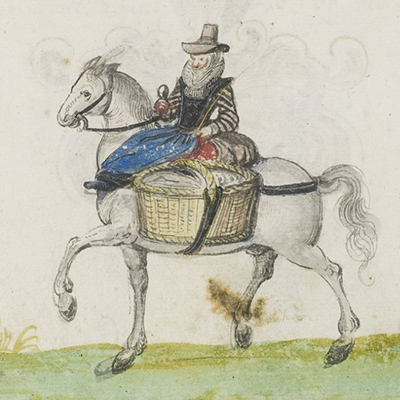Woman riding Packhorse with Paniers

Detail from the Album Amicorum of Michael van Meer, fol. 157v
©University of Edinburgh Library, Laing Collection La.III.283
Reproduced under (CC BY 3.0)
According to his Album Amicorum (fol.18r, the original page 1), Michael van Meer (c.1590-1653) was a lieutenant in Hamburg when he died there on 13 October 1653. He belonged to an armigerous family (see the same page) and is frequently addressed by his contributors in terms which suggest that he was a nobleman. He spent some time in London between 1614 and 1617 — fol. 220v of his Album records the death of a friend of his, Ulric Blucher, who ‘died in my arms in London on the 7 September 1614, and was honourably buried in St Mary’s (at Hill) near Billingsgate on the 9th of the same month’.1 A detailed search through the dedications of the autographs would enable his travels, and his relationships, to be plotted more closely.
Alba Amicorum are often described as ‘a kind of autograph album’: in his case he seems to have taken the autograph-hunting seriously. His catch in 1614 included King James I and VI, Queen Anna, and Prince Charles (who had just become heir apparent on the death of his elder brother Henry in 1612), all with their mottoes — James’ is Parcere subjectos et debellare superbos — besides a goodly number of the English nobility, all Knights of the Garter, and Prince Mauritz of Nassau, also as a Garter knight. He illustrates several episodes from the Garter procession (see e.g. fols 58r, 57v, 385v) with the groups numbered in a way that suggests he was copying it from a printed roll. Later he collects the autographs of Christian IV of Denmark, Anna’s brother (fol. 31r), and other European royalty and nobility.
He also provides a variety of spirited drawings of English costume, especially of ordinary people, which include this peasant woman coming to market (fol. 157r). As with all Album Amicorum pictures, it is difficult to tell if they are drawn from the life, or adaptations of prints.2 The upper part of the countrywoman looks like the 1575 drawing by Lucas de Heere fitted with a ruff. And is the young American Indian surrounded by exotic animals in the Zoo in St James’ Park, dated 1615/1616 (fol. 264v) a snapshot or worked up from a costume book? Then there is the question of its relationship with Folger Shakespeare Library MS ART Vol. c91, a collection of 35 watercolour paintings of costume from the time of James I. At least ten of the images, including this one, are identical, though the Folger manuscript separates them out into individual pages, and they are not captioned.
Find the full image of the Edinburgh version on this page of thumbnails at: Edinburgh University Library Luna website.
1. His Christian name, and that he was a -nobleman of Pomeray’ (from the Duchy of Pomerania on the Baltic; the capital Szczecin is 340km from Hamburg) are supplied by the burial registers of St Mary-at-Hill. Return
2. An image of Windsor Castle (fol. 179r) which ‘Carl van de Linden made with his own hand’ is actually copied from a section of Braun and Hogenberg’s prospect with some rearrangement of foliage and the removal of the figures in the foreground: compare with the 1575 copy in the British Museum Collection.
Close window to return.